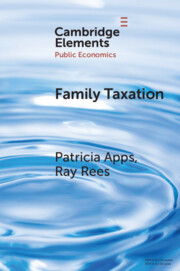Refine search
Actions for selected content:
9 results

Family Taxation
-
- Published online:
- 21 April 2025
- Print publication:
- 22 May 2025
-
- Element
- Export citation
The incidence of Social Security taxes on teacher wages and employment
-
- Journal:
- Journal of Pension Economics & Finance / Volume 24 / Issue 3 / July 2025
- Published online by Cambridge University Press:
- 12 December 2024, pp. 351-370
-
- Article
-
- You have access
- Open access
- HTML
- Export citation
Fiscal stimulus and pension contributions: evidence from the TCJA
-
- Journal:
- Journal of Pension Economics & Finance / Volume 24 / Issue 2 / April 2025
- Published online by Cambridge University Press:
- 06 November 2024, pp. 209-234
-
- Article
- Export citation
Political regimes and firms' decisions to pay bribes: theory and evidence from firm-level surveys
-
- Journal:
- Journal of Institutional Economics / Volume 19 / Issue 6 / December 2023
- Published online by Cambridge University Press:
- 12 June 2023, pp. 764-786
-
- Article
-
- You have access
- Open access
- HTML
- Export citation
A Better and Larger GST?
-
- Journal:
- The Economic and Labour Relations Review / Volume 22 / Issue 3 / November 2011
- Published online by Cambridge University Press:
- 01 January 2023, pp. 85-100
-
- Article
- Export citation
Subsidy Incidence in Privately Negotiated Spot Markets: Experimental Evidence
-
- Journal:
- Journal of Agricultural and Applied Economics / Volume 51 / Issue 2 / May 2019
- Published online by Cambridge University Press:
- 07 February 2019, pp. 219-234
-
- Article
-
- You have access
- Open access
- HTML
- Export citation
Implications of The National Employment Savings Trust for Vulnerable Sectors of the UK Labour Market: A Reduced-Form Statistical Evaluation
-
- Journal:
- National Institute Economic Review / Volume 219 / January 2012
- Published online by Cambridge University Press:
- 26 March 2020, pp. R77-R89
- Print publication:
- January 2012
-
- Article
- Export citation
La recaudación fiscal en el mundo rural de la Restauración: obstáculos y resistencias*
-
- Journal:
- Revista de Historia Economica - Journal of Iberian and Latin American Economic History / Volume 21 / Issue 3 / December 2003
- Published online by Cambridge University Press:
- 28 April 2010, pp. 501-523
- Print publication:
- December 2003
-
- Article
- Export citation
Access charge and imperfect competition
-
- Journal:
- Recherches Économiques de Louvain/ Louvain Economic Review / Volume 69 / Issue 3 / 2003
- Published online by Cambridge University Press:
- 17 August 2016, pp. 319-340
- Print publication:
- 2003
-
- Article
- Export citation
